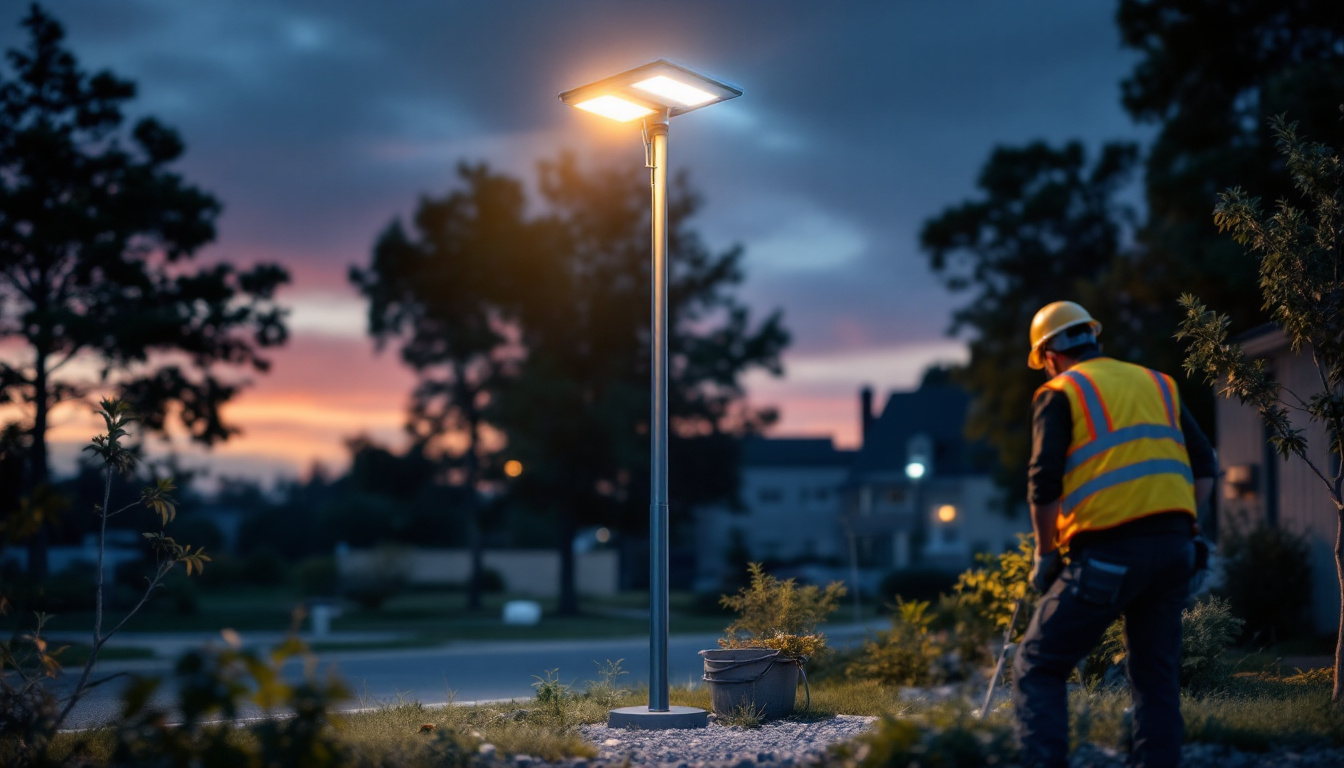

As the demand for sustainable energy solutions continues to rise, solar light poles have emerged as a popular choice for outdoor lighting. These innovative structures not only provide illumination but also contribute to energy conservation and environmental protection. For lighting contractors, understanding the intricacies of solar light poles is essential for effective installation and client satisfaction. This article delves into the key aspects of solar light poles, offering insights that can enhance the expertise of lighting professionals.
Solar light poles are self-sustaining lighting systems that harness solar energy to power LED lights. They consist of several key components, including solar panels, batteries, LED fixtures, and control systems. The integration of these elements allows for efficient energy use and minimal maintenance, making them an attractive option for various applications.
To fully appreciate the functionality of solar light poles, it is important to understand their main components. The solar panel is responsible for capturing sunlight and converting it into electricity. This energy is then stored in batteries, which power the LED lights during nighttime. The control system manages the operation of the lights, ensuring they turn on and off at appropriate times.
In addition to these primary components, solar light poles may include features such as motion sensors, dimming capabilities, and remote monitoring systems. These enhancements can improve energy efficiency and provide added convenience for users. For example, motion sensors can detect movement and adjust the brightness of the lights accordingly, conserving energy when the area is unoccupied. Remote monitoring systems allow for real-time data collection on energy usage and battery status, enabling proactive maintenance and optimization of the lighting system.
There are various types of solar light poles available, each designed for specific applications. For instance, some models are tailored for street lighting, while others are better suited for parks, pathways, or parking lots. Understanding the differences between these types is crucial for contractors when selecting the appropriate solution for a project.
Street lighting solar poles typically feature higher lumen outputs to illuminate wider areas, while pathway lights may have a more focused beam. Additionally, the height and design of the poles can vary, impacting both aesthetics and functionality. Decorative solar light poles, for example, are often used in urban settings to enhance the visual appeal of public spaces while providing effective illumination. These poles can come in various styles, from traditional to modern, allowing cities to maintain their unique character while benefiting from renewable energy solutions. Furthermore, some solar light poles are designed with integrated features such as planters or seating, promoting greenery and community engagement in outdoor environments.
The advantages of solar light poles extend beyond mere energy savings. They offer a multitude of benefits that can enhance the overall value of lighting projects.
One of the most significant benefits of solar light poles is their positive impact on the environment. By utilizing renewable energy, these systems reduce reliance on fossil fuels and lower greenhouse gas emissions. This aligns with global efforts to combat climate change and promotes a healthier ecosystem.
Furthermore, solar light poles can be installed in remote locations where traditional electrical infrastructure is not feasible. This flexibility allows for sustainable lighting solutions in areas that would otherwise remain dark, improving safety and accessibility. In addition, solar light poles often feature LED technology, which not only consumes less energy but also has a longer lifespan compared to traditional bulbs. This means fewer replacements and less waste, contributing to a more sustainable approach to urban and rural lighting.
While the initial investment in solar light poles may be higher than conventional lighting systems, the long-term savings can be substantial. Reduced energy bills, minimal maintenance costs, and the absence of wiring expenses contribute to overall cost-effectiveness. For contractors, this can be a compelling selling point when discussing options with clients.
Moreover, many regions offer incentives and rebates for solar installations, further offsetting costs. Contractors should stay informed about local regulations and financial incentives to provide clients with comprehensive information. Additionally, the durability of solar light poles, often designed to withstand harsh weather conditions, means that they require less frequent replacements, which can lead to significant savings over time. This durability not only enhances the value proposition for clients but also reinforces the reliability of solar technology as a viable option for modern lighting solutions.
Installing solar light poles requires careful planning and consideration. Lighting contractors must take into account various factors to ensure successful implementation.
A thorough site assessment is critical before installation. This involves evaluating the location for sunlight exposure, potential obstructions, and the specific lighting requirements of the area. Conducting a shade analysis can help determine the optimal placement of solar panels, maximizing their efficiency.
Additionally, understanding the local climate is essential. Regions with frequent cloud cover or heavy rainfall may require different specifications or additional battery capacity to ensure reliable performance throughout the year.
Contractors must also be aware of local regulations and codes governing the installation of solar light poles. This includes zoning laws, electrical codes, and any necessary permits. Ensuring compliance not only avoids potential legal issues but also enhances the credibility of the contractor.
In some cases, working with local authorities can lead to collaborative projects that benefit the community, such as installing solar light poles in public parks or along bike paths.
One of the appealing aspects of solar light poles is their low maintenance requirements. However, routine checks and maintenance are still necessary to ensure optimal performance.
Contractors should advise clients on the importance of regular inspections to identify any issues early on. This includes checking the solar panels for dirt or debris that may hinder their efficiency, as well as ensuring that the LED lights are functioning correctly.
Battery health is another critical aspect to monitor. Over time, batteries may degrade and require replacement. Understanding the expected lifespan of different battery types can help contractors provide accurate information to clients regarding maintenance schedules.
The technology surrounding solar light poles is continually evolving. Contractors should stay informed about the latest advancements in solar technology, such as improved battery efficiency, enhanced LED lighting, and smart control systems. Offering clients the most up-to-date solutions can set a contractor apart in a competitive market.
Additionally, integrating smart technology, such as IoT capabilities, can provide clients with valuable data regarding energy usage and system performance. This not only enhances the functionality of solar light poles but also appeals to clients interested in modern, tech-driven solutions.
Examining successful case studies can provide valuable insights for lighting contractors considering solar light poles for their projects. Various applications demonstrate the versatility and effectiveness of these systems.
In urban settings, solar light poles have been successfully integrated into streetscapes, parks, and public spaces. For example, a city may implement solar lighting along a popular walking path to enhance safety and visibility at night. The absence of electrical wiring simplifies installation and reduces costs, making it an attractive option for municipalities.
Moreover, the aesthetic appeal of solar light poles can contribute to the overall design of urban spaces, providing both functionality and visual enhancement.
Solar light poles have proven to be invaluable in rural and remote areas where traditional lighting infrastructure is lacking. For instance, a small community may install solar lights along its main road to improve safety for residents and visitors. This not only enhances visibility but also fosters a sense of security in the area.
In these settings, the ability to operate independently of the grid is a significant advantage, allowing for sustainable lighting solutions without the need for extensive electrical installations.
The future of solar light poles is promising, with several trends emerging that could shape the industry. Lighting contractors should be aware of these developments to remain competitive and informed.
As cities increasingly adopt smart technologies, solar light poles are becoming integral components of smart city initiatives. By integrating sensors and connectivity features, these systems can provide real-time data on energy consumption, traffic patterns, and environmental conditions.
This data can inform city planning and enhance public safety, as well as improve the efficiency of energy use. Contractors who understand the implications of smart city technology can position themselves as leaders in this evolving market.
Another trend is the growing demand for customization in solar light pole designs. Clients are seeking solutions that not only meet functional requirements but also align with their aesthetic preferences and branding. Contractors who can offer tailored solutions will likely find greater success in attracting diverse clientele.
From color options to pole designs, the ability to customize solar light poles can set a contractor apart and cater to the unique needs of various projects.
Solar light poles represent a significant advancement in outdoor lighting technology, offering numerous benefits for lighting contractors and their clients. By understanding the components, advantages, installation considerations, and emerging trends, contractors can effectively navigate the solar lighting landscape.
As sustainability becomes increasingly important in the construction and design industries, the role of solar light poles will only continue to grow. Lighting contractors who embrace this technology and stay informed about developments will be well-positioned to meet the evolving needs of their clients and contribute to a more sustainable future.
Ready to elevate your lighting projects with the most sustainable and innovative solutions? Look no further than LumenWholesale for all your solar light pole needs. Our commitment to quality and affordability ensures that you receive spec-grade lighting products that exceed industry standards, all at unbeatable wholesale prices. Say goodbye to middleman markups and hello to hassle-free bulk buying with free shipping. Don’t compromise on quality or cost—choose LumenWholesale for premium lighting that blends seamlessly with your commitment to a sustainable future. Start experiencing the difference today by visiting our selection at Wholesale Lighting at the Best Value.

Discover the essential guide for lighting contractors on mastering the 3-way switch.

Discover the top strategies lighting contractors use to maximize efficiency and aesthetics with LED bay lights.

Discover expert insights on selecting the best LED bulbs for home installations, tailored specifically for lighting contractors.

Discover the essential insights every lighting contractor needs to master recessed lighting installations.
Get notified when NEW deals are released.
Optimize your budget with wholesale discounts.
Only top-quality, specification-grade lighting products.
No additional costs at checkout - what you see is what you pay.
We understand the unique needs of contractors.